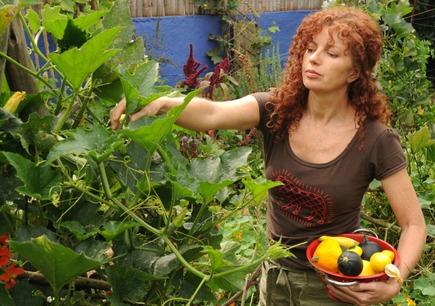
02 Sep Our Fireside Chat with Organic Jane
Spring has sprung and the earth is simply bursting with new life. This time of year often inspires people to start cultivating some greenery of their own – be it a flower pot on your windowsill or an organic veggie patch in the garden, we all have to start somewhere. Faithful to Nature got a very special chance to chat to Jane Griffiths, the local author whose debut book, Jane’s Delicious Garden, sparked an organic gardening revolution in South Africa. We got to know a bit more about Jane, what inspired her and most importantly she has shared some of her top sustainable gardening tips as well as some inspiration for newbie gardeners.
Who is Jane?
I am a television producer, an artist, a traveller, an author and a gardener.
What led you be such a passionate advocate of organic and natural gardening?
I had been growing my own organic vegetables for many years when a friend approached me for help. I didn’t realise how much knowledge I had gathered until he started asking questions – and I could answer every single one. I thought if he needed help, others would too, so I started writing a script for a DVD. Within a few days I had written 20,000 words – way more than a DVD script. I realised I was writing a book. That was Jane’s Delicious Garden which has now sold over 21,000 copies. It led to three more best sellers and I now travel around the country giving talks and sharing information on how to grow organically.
What is your favourite meal to grow?
It all depends on the season – in mid winter, a delicious hearty salad with a mixture of tasty leaves such as mustard, tat soi, baby bok choy and kale, topped with baby peas and roasted sweet potato (or butternut) cubes with sprinkles of coriander, parsley and chives. In summer I am spoiled for choice – I grow a variety of squash and often use a spiral slicer to create zucchini “pasta” with fresh cherry tomatoes, basil and mozzarella cheese. I also have three hens and three bantams – so we have fresh free range eggs that we eat regularly. Whatever is in season in my garden is what inspires the next meal.

What are your top tips for running a sustainable garden?
- Early on in my gardening journey I discovered the joys and benefits of no-dig gardening. In many gardens it is a tradition to dig up the soil regularly, beating the earth with a fork to break up the clods and loosen the soil. The good news is – you can say goodbye to all that work because digging up and turning over the earth is more harmful than beneficial to the soil. Every time you dig, you are destroying and upsetting the balance of billions of beneficial soil organisms. You also lose moisture plus the nutrients dissolved in the moisture. And, finally, digging causes dormant weed seeds to surface and germinate. Instead of digging, simply add organic matter to the surface of the soil – nature is designed to incorporate it into the lower layers. If you create small beds with raised edges and don’t stand on the soil it won’t become compacted.
- Create your own compost and always recycle and reuse before buying something new
- Learn to sow from seed and how to save seeds – this will save you spending money on seed and seedlings.
- Gain as much knowledge as possible about your garden and its cycles, plants, soil and insects. You can buy all the gadgets you want – but the best tool you can have is knowledge.

What are the top 3 things on your bucket list?
- To visit the beautiful gardens of the Loire valley in France.
- To eat a meal at the French Laundry in Napa Valley.
- To paint the glaciers in Alaska.
Where is the best place to start for newbie gardeners?
Start small with one bed or one container and learn to manage that before expanding. Begin with easy vegetables such as beans, Swiss chard, lettuce, cherry tomatoes, basil and chives.

All images courtesy of Keith Knowlton & Jane Griffiths.
You can purchase Jane Griffiths best selling books from us here.
Visit Jane’s website here.



No Comments